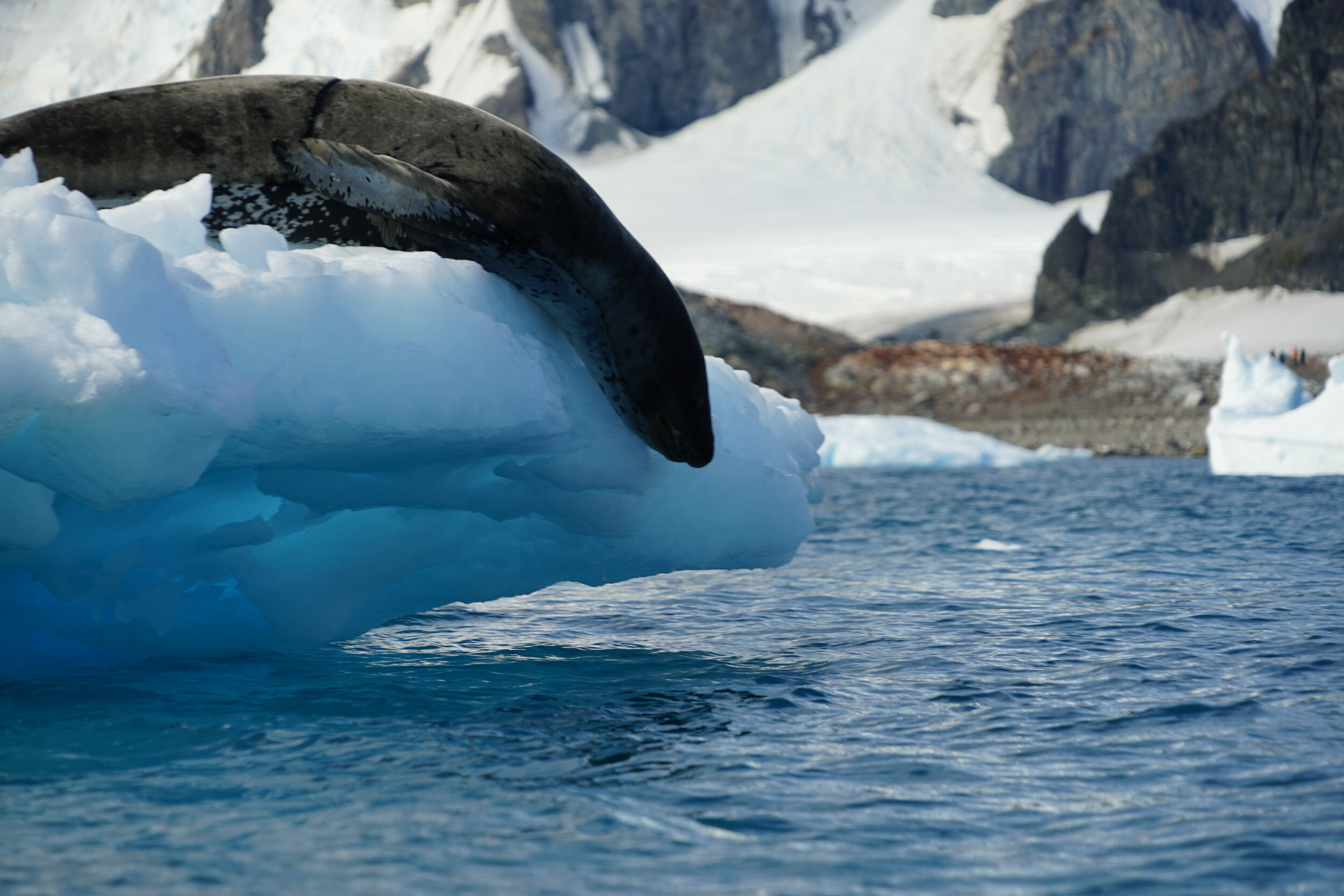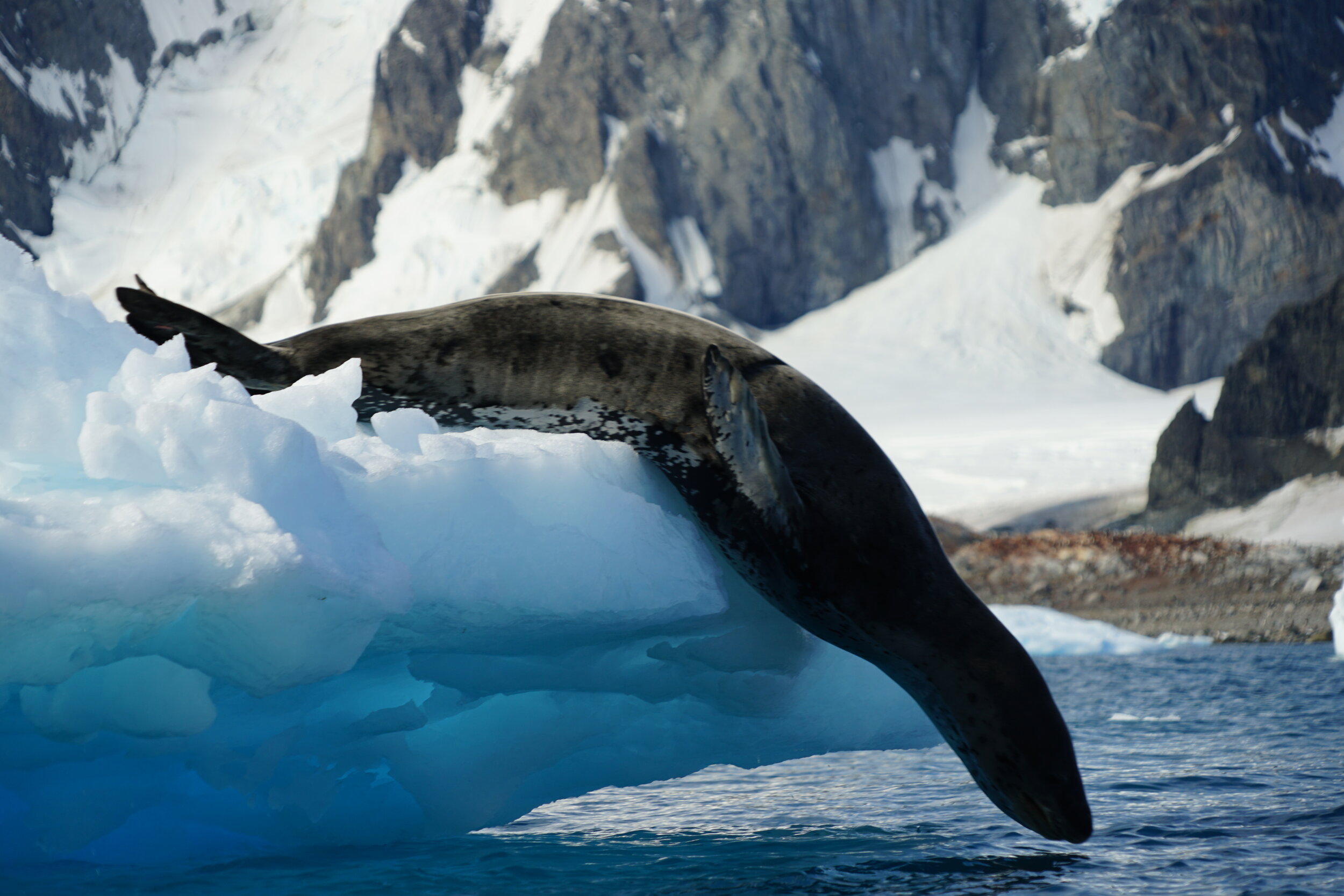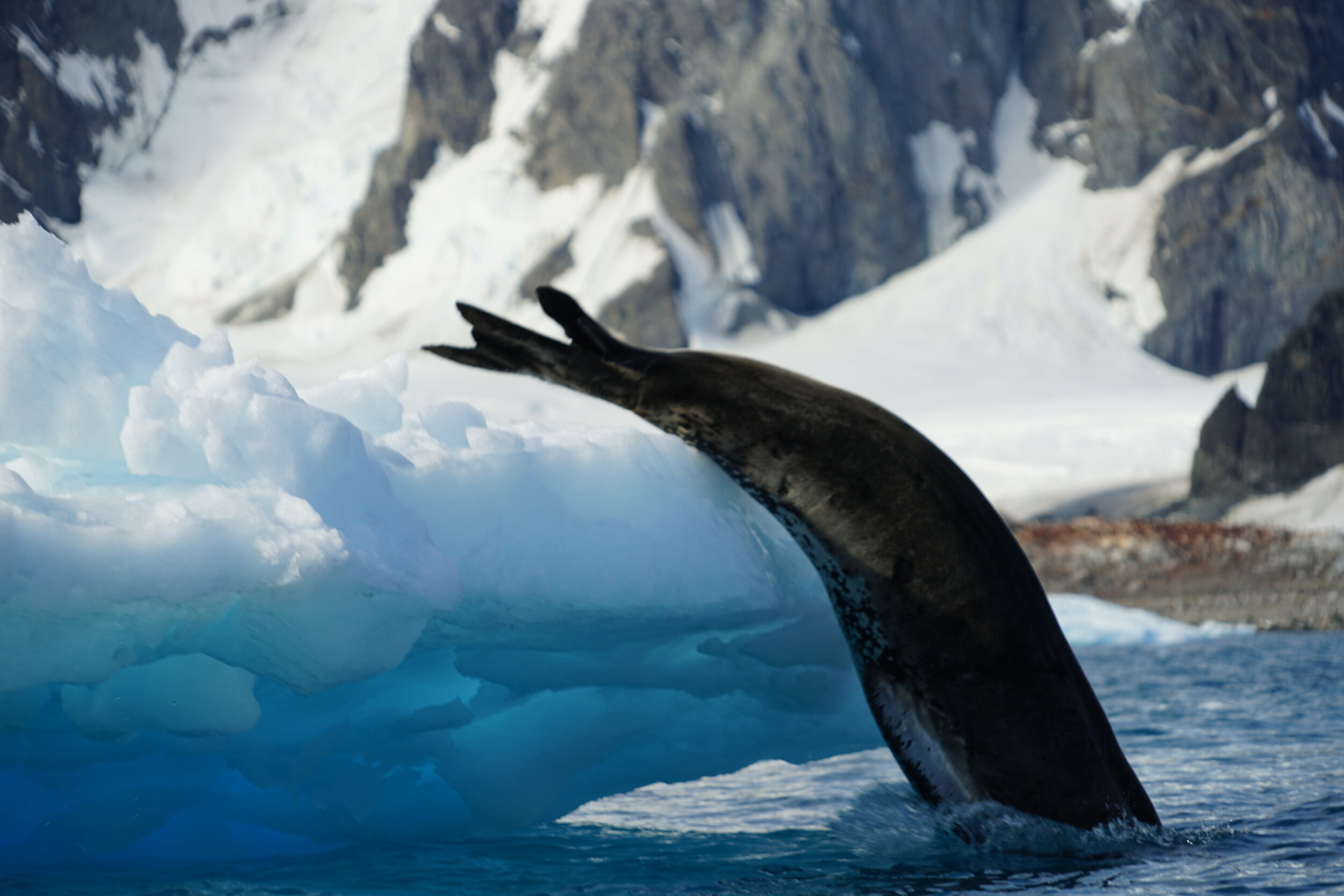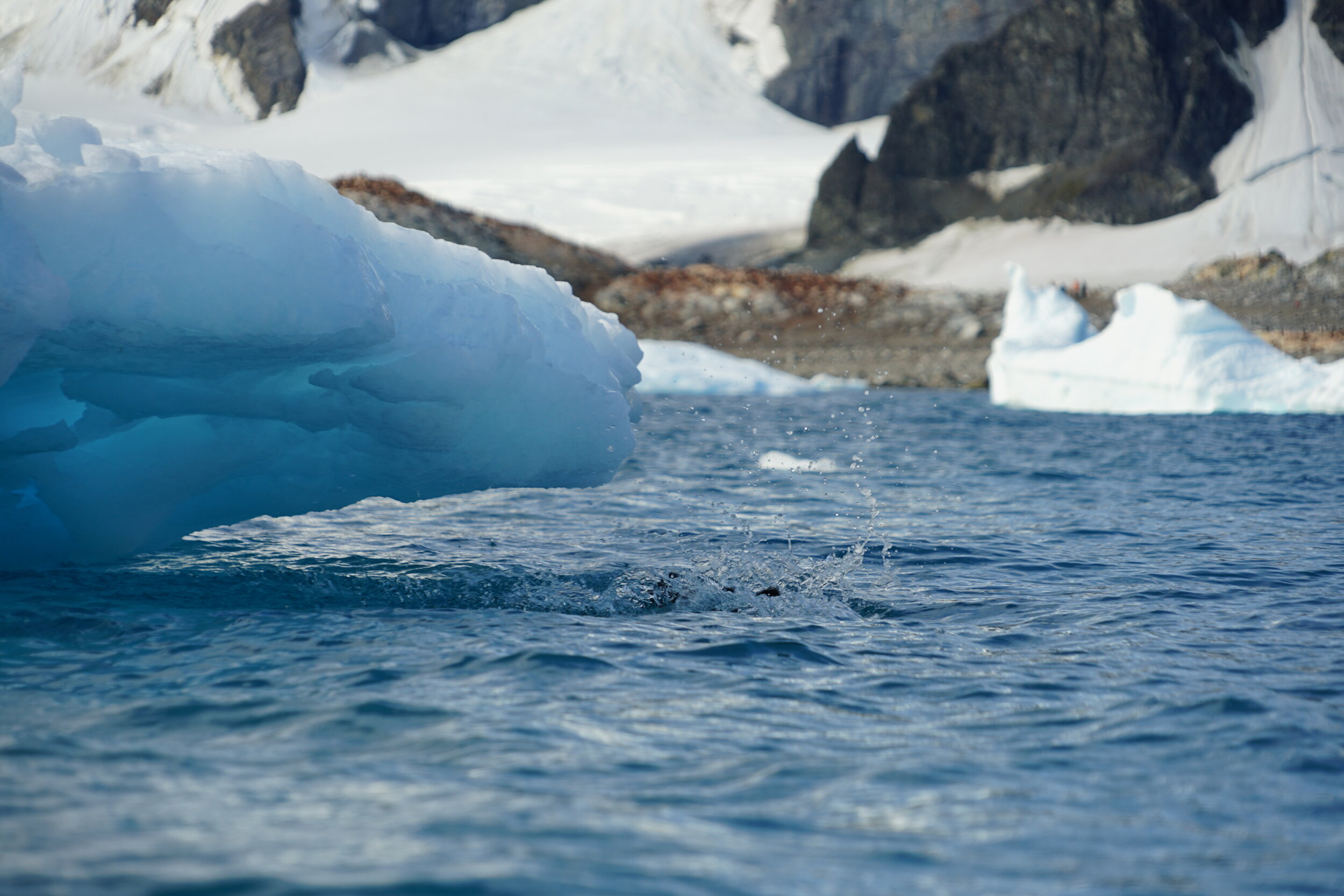There is much to learn if you are curious
Leopard seals are one of the most curious and obviously intelligent animals I have ever encountered. Being lucky enough to kayak in their environment I have had some unique encounters that I think are worth sharing.
Encounters with Leopard seals from a kayak bring a lot of emotions, fear being the first. But after several close encounters the wide eyed fear you initially have turns to an expression of awe. As a guide I look at expressions of my fellow kayakers; mouths open, no one able to take their eyes off the inquisitive and intimidating expression of the seal assessing what sort of ice we rest upon.
My first really close encounter with a leopard seal was with a group of rafted kayakers. All six kayaks grouped together as we looked for a good spot to land on a nearby island, all of sudden a leopard seal rose out of the water to eye level with us. It took about 30 seconds to look each of us in the eye before disappearing back in to the water. Incredible! (video of this encounter is shown further down in the story). Since then I’ve been lucky enough to spend more time kayaking around the antarctic peninsular and have had other close encounters with the cheeky and scheming leopard seals that call it home.
Having such incredible experiences with these animals caused a curiosity in me to understand the life of a Leopard seal.
There is much to learn if your are curious.
The gender of a seal can easily be known from a photo of the underside of a seal like this. Both sexes have a scar from the umbilical attachment (belly-button), behind this females have two mammary glands shown vertically like this : , while males have just one opening part way to the hind flippers.
What sex is this seal?
Who is she and what is she doing in Antarctica?
Named after their spotted fur and sharp canines, Leopard seals (Hydrurga leptonyx) are often named alongside killer whales as Antarctica’s top predator. Hydrurga leptonyx loosely translates to the small clawed, water worker. They have huge and powerful for-flippers and are extremely agile and hydrodynamic in the water. What gives them away when looking from a distance is their large reptilian head and neck. While they are a top predator if you looked at an antarctic food web they have connections to almost every level. This cosmopolitan diet is one of the most intriguing aspects of their ecology. They are sexually dimorphic with females being larger than males reaching almost 500kg at 3.8m in length.
The leopard seal yawn - a moment every photographer has their camera poised for.
What can her teeth tell us?
The best way to tell what something eats is to have a look at their teeth! With Leopard seals their varied diet is reflected in their unusual tooth structure. The large 2.5cm canines are easy to see, and are used to deal with bigger prey like other seals, penguins and fish. However in the back of their mouth are a set of serrated teeth used to strain krill from the water.
Tools of the trade: Leopard seals use their strong front teeth to kill penguins, while the trident-shaped cheek teeth act as a sieve for trapping tiny krill. Source
The first time this was observed was in Australia with captive leopard seals. The scientists witnessed the sucking and sieving of prey similar to how many whales feed. This study came about when researchers were looking at the evolution of baleen in ancient whales like Llanocetus and saw the comparison to the present day Leopard seals teeth (more on this study can be seen here). This was a fundamental study showing how leopard seals can occupy a place at the top or bottom of the Antarctic food web depending on prey abundance. It is thought that Leopard seals consume more Antarctic krill during the winter when other prey are less densely located around breeding sites. However research from one juvenile shows they have an aerobic dive limit of seven minutes which means that in the winter months juvenile Leopard seals probably don’t eat krill, since krill is found deeper during this time.
Video from an underwater ROV near Cuverville island, Antarctica.
Bonus points if you can spot the salps!
The most beautiful swimmers on earth
As I hope you can see from this footage they swim effortlessly with powerful yet graceful movements. What you cannot see in this video is the speed of the leopard seal, propelled by all four limbs these animals can truly fly underwater. I’ve had a Leopard seal porpoising behind my zodiac at over 15 knots. Most true seals only use their forelimbs as rudders so it is unique that leopard seals have the huge pectoral flippers used for propulsion.
They are incredibly streamlined, you can see the nostrils and lips tightly shut as they approach the camera their entire torso is in a teardrop shape. Their muzzles are dotted with whiskers to feel any movements in the water. The most similar thing to our fingertips.
Photos taken from a kayak… and then what happened?
Behaviour and nature towards humans
These curious animals have a long history of interacting with humans and no doubt when in their environment they need to be treated with the respect of the apex predator. There has been a few negative interactions with humans, firstly back in the heroic age of antarctic exploration. Sir Ernest Shackleton's Imperial Trans-Antarctic Expedition of 1914–1917 had a seal chase one of their expedition members across the ice, only to be stopped when shot by experienced polar explorer Frank Wild. However there is an overwhelming amount of documented cases of positive encounters with these animals. Most well known are the encounters Paul Nicklen has shared with National geographic. These encounters help to show the curiosity and inquisitive nature of these seals which is important as we still know very little about antarctic seals. Human / Leopard seal interactions are likely to increase as antarctic tourism grows and seals explore territories further north. They have recently become a resident species in New Zealand! So it is important that peoples perspective is not one of fear of the unknown but more of a curious and playful underwater superior who might just be able to teach us something if we watch and listen.
My personal experiences with leopards have been incredible, and mostly from a kayak which I enjoy as it feels like a more intimate way to connect with the environment. While kayak guiding it is known that you shouldn’t seek out encounters with these animals because of the potential risks but of course when you are exploring someones backyard you are bound to run into them at some point.
Encounters from a kayak
The video below is from the encounter I eluded to at the start, and quite possibly my favourite encounter to date.
It was a typical late summer day in Antarctica, large snow flakes falling around us as we paddle between ice floes, looking down into the clear shallow water observing chains of salps floating by. No one was in a hurry to leave the peaceful bay we were in and paddle to the nearby island to land so we rafted together to have a yarn. As I joined the other kayaks I looked behind me to see the shape of a Leopard seal disappear underwater! I was feeling a mix of emotions, my first encounter with a leopard seal while kayaking, should I be nervous? a little… I was however super excited to see this animal up close! While telling the group who was approaching she circled around our kayaks and I quickly clipped a Gopro to the end of my paddle and this is what I got.
An incredible encounter watching this animal for about ten minutes before she swam off to investigate a zodiac which approached us (this did end in the zodiac with a punctured tube when she tested the material with her teeth). What an incredible day and I was left wanting more!
The hunt…
Other incredibly memorable encounters have occurred while watching Leopard seals feed on juvenile Adelie penguins. The seal patrols the water around the ice edge, eyes just rising above the waters surface just how you would imagine a crocodile doing. The seal waits for birds to take the plunge, sometimes inpatient the seal launches out of the water almost coming face to face with a penguin this usually causes enough of a commotion to knock a few unlucky birds into the water. From what I’ve seen they kill the bird by grabbing the feet or neck and slapping the backwards and forth onto the waters surface (a violent kill I know! however the next part is even crazier). This powerful action often turns the penguins skin inside out, essentially skinning the penguin so the seal can just eat the meat without feathers in the way. During one such encounter it seemed like the seal was just doing this just for fun or practice. I could count six inside out penguins floating around the sea as he eyed up his next victim. This could have been a form of prey stashing but a curious behaviour nonetheless
Antarctica and climate change are almost synonymous, most of the effects we talk about are negative for wildlife, as most animals are specially adapted to one prey or habitat. In a constantly changing world there is a lot to be said for a species that is quick to adapt and curious about the world around them. As we talked about these encounters afterwards, we discussed how the leopard seal might well be adaptable enough to fit into a changing antarctic environment.
Conservation & Science
Leopard seals are currently listed as lower risk, least concern by the International Union for Conservation of Nature (IUCN). The main conservation issue facing leopard seals and much of the Antarctic food web is is the reduction in krill stocks, which is expected with climate change and the possibility of krill fisheries fishing in habitat these animals use. There are a few citizen science projects helping to understand leopard seals through mark recapture research, based on photographs of unique spots around the head. There is the Sea Leopard Project for antarctic sightings and Leopardseals.org for sightings in New Zealand.
Cuverville Island. a likely spot to find Leopard seals in the late summer as Gentoo penguin chicks take their first swim.
There is much I haven’t covered about leopard seals in this blog… comment and message me if you want to know more or have any questions!
Thanks for being curious.







